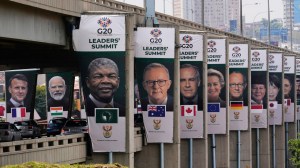What Jaswant’s budget means
Mr Atal Behari Vajpayee has extraordinary luck on his side — and its name is Mr Jaswant Singh. Few Finance Ministers have had the kind ...

Mr Atal Behari Vajpayee has extraordinary luck on his side — and its name is Mr Jaswant Singh. Few Finance Ministers have had the kind of luck that Mr Jaswant Singh has enjoyed in the first eighteen months in office. And only Mr Singh, I believe, with his military bearing and deadpan expression, could have pulled off a coup with his dramatic announcement that the year 2003-04 will end with a fiscal deficit of 4.8 per cent of GDP, lower than the budget estimate of 5.6 per cent. If my memory serves me right, it is the first time since 1991 that the revised estimate of the fiscal deficit is lower than the budget estimate. (In 1996-97 it was on the dot.)
The Finance Minister has gone further. He has predicted that the fiscal deficit for the next year (2004-05) will be even lower at 4.4 per cent.
If these figures are true, as I must assume for the present they are, there is good reason for the government to boast, in the words of the Finance Minister, ‘‘I trust, Sir, that Hon’ble Members would observe, and approve of the fact, that the Government has demonstrated its resolve about fiscal consolidation by performing better than its budgeted targets.’’ I shall return to this later.
No surprises
The Interim Budget contains no surprises. Following his own announcements a few days earlier, and the announcements of the Railway Minister and the Commerce Minister, it was expected that the Finance Minister too would spread the so-called ‘‘feel good’’ factor. He did not disappoint, and he has spread the ‘‘butter’’ across more sections of the people.
The Interim Budget also reveals a familiar story. Defence expenditure did not meet the target (Rs 16906 crore against Rs 20953 crore). Other non-Plan capital expenditure was also below target (Rs 2231 crore against Rs 3757 crore). The internal and extra-budgetary resources (IEBR) raised were only Rs 68,919 crore against the budget estimate of Rs 75,741 crore. This gap — a hardy perennial — showed up in the capital outlay of key ministries and departments.
The Ministry of Agriculture was able to invest only Rs 3170 crore (against the proposed Rs 3242 crore); the Ministry of Chemicals and Fertilisers Rs 554 crore (against Rs 1168 crore); the Ministry of Civil Aviation Rs 1486 crore (against 1779 crore); the Ministry of Coal Rs 2515 crore (against Rs 3321 crore); the Ministry of Mines Rs 526 crore (against Rs 888 crore); the Ministry of Communication Rs 13532 crore (against Rs 15682 crore); the Ministry of Health and Family Welfare Rs 6283 crore (against Rs 6630 crore); the Department of Women and Child Development Rs 2150 crore (against Rs 2600 crore); the Ministry of Power Rs 12038 crore (against Rs 14668 crore); the Ministry of Science and Technology Rs 1315 crore (against Rs 1580 crore); the Ministry of Shipping Rs 1487 crore (against Rs 2545 crore); the Ministry of Steel Rs 855 crore (against Rs 1461 crore); and the Ministry of Textiles Rs 679 crore (against Rs 764 crore).
Quality of governance
Thus, across the spectrum, from agriculture to manufacturing to infrastructure to social justice, there were critical shortfalls in capital plan outlay — that is investments. Apart from slowing down current growth, there is also the ‘‘opportunity cost’’ of not making the crucial investments in time. Among the few ministries/departments that have outperformed the budget estimates of capital plan outlay are Elementary Education, Petroleum and Natural Gas, Rural Development and Urban Development. Here is an opportunity for the Prime Minister to rate the performance of his ministers — call the minister and ask him or her why targets were not met, why projects fell behind schedule. The Prime Minister may be surprised to find that many ministers will be clueless. Despite six years at the helm of affairs, the quality of governance under Mr Vajpayee has not improved.
Among the poorly performing ministries are Defence (shortfall in capital expenditure), Home (deteriorating law and order), Personnel (the CBI’s poor record of convictions) and Law (vacancies in High Courts and backlog of cases). The Interim Budget is mainly a reiteration of existing programmes. An assortment of new programmes has also been announced targeting specific voter groups. Some are indeed reformist — for example, the Farm Income Insurance Scheme, the Stamp Duty Reform and the Accelerated Drinking Water Supply Scheme for mega cities. Some are plainly populist such as the merger of dearness allowance with the basic pay of government servants, the Laghu Udyami Credit Card scheme (for small and medium enterprises) and the liberalisation of free baggage allowance. Many others are just announcements with no indication of the source of funds. No funds have been provided for the Agriculture Infrastructure and Credit Fund or the Small and Medium Enterprise Fund or the Industrial Infrastructure Fund. The Indira Gandhi canal project has been promised ‘‘innovative funding’’. The PURA scheme, a favourite of President Abdul Kalam, has been provided a token allocation of Rs 1 crore.
The Interim Budget suffers from the usual weaknesses associated with the NDA regime. It does not address the question of unemployment (nor does it repeat the false claim of the Planning Commission that 83 lakhs jobs per year were, or are being, created). It does not explain the poor demand for investment; nor does it propose any initiatives to attract investment. It does not explain the rising trend in the rate of inflation.
Unnecessary spin
Let me get back to the fiscal deficit. The budget estimates and the revised estimates, as given in the budget papers, are not comparable. There is a ‘‘spin’’ on two key figures: ‘‘Recoveries of loans’’ and ‘‘Non-plan expenditure on capital account’’. There is a footnote under each, but the footnotes confuse than clarify. I have, therefore, eliminated the spin and taken the budget estimates as the revised estimates under these two heads. The result is that the fiscal deficit is Rs 139,195 crore rather than Rs 132,103 crore. This translates to 5.05 per cent of GDP rather than 4.8 per cent. Mr Vajpayee’s first three batsmen (the ministers of Finance, Railways and Commerce) have scored enough runs to boost the side’s total to about 300 runs. At the rate of run-a-ball, it is a reasonable score to defend, but not unbeatable. Now, over to the Congress and its manifesto.
Write to pcexpressindia.com





- 01
- 02
- 03
- 04
- 05


























